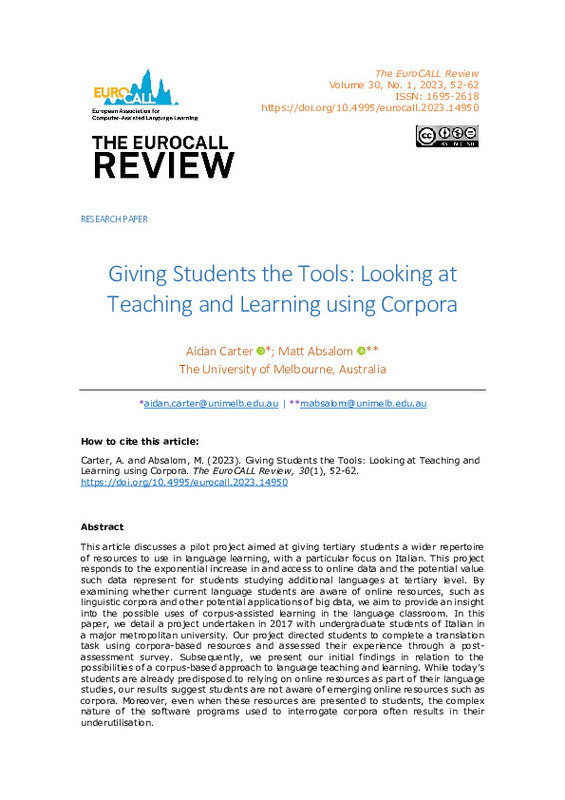Abrams, Z., & Schiesti, S.B. (2017). Using Authentic Materials to Teach Varieties of German: Reflections on a Pedagogical Experiment. Unterrichtspraxis/Teaching German, 50(2), 136–150. https://doi.org/10.1111/tger.12038
Backus, A. (2008). Data Banks and Corpora. In Wei, L. and Moyer, M.G. (Eds.), The Blackwell Guide to Research Methods in Bilingualism and Multilingualism (pp. 232–248). Wiley-Blackwell.
Boulton, A. (2010). Data-driven learning: Taking the computer out of the equation. Language Learning, 60(3), 534–572. https://doi.org/10.1111/j.1467-9922.2010.00566.x
[+]
Abrams, Z., & Schiesti, S.B. (2017). Using Authentic Materials to Teach Varieties of German: Reflections on a Pedagogical Experiment. Unterrichtspraxis/Teaching German, 50(2), 136–150. https://doi.org/10.1111/tger.12038
Backus, A. (2008). Data Banks and Corpora. In Wei, L. and Moyer, M.G. (Eds.), The Blackwell Guide to Research Methods in Bilingualism and Multilingualism (pp. 232–248). Wiley-Blackwell.
Boulton, A. (2010). Data-driven learning: Taking the computer out of the equation. Language Learning, 60(3), 534–572. https://doi.org/10.1111/j.1467-9922.2010.00566.x
Boulton, A. (2017). Data-driven learning and language pedagogy. In Thorne, S. & May, S. (Eds.), Language, Education and Technology: Encyclopedia of Language and Education (pp. 1–12). Springer. https://doi.org/10.1007/978-3-319-02328-1_15-1
Braun, S. (2006). ELISA—A pedagogically enriched corpus for language learning purposes. In Braun, S., Kohn, K. & Mukherjee, J. (Eds.), Corpus technology and language pedagogy: New resources, new tools, new methods (pp. 25–47). Peter Lang.
Feldstein, M. (2013). Why Big Data (Mostly) Can’t Help Improve Teaching. E-Literate, http://mfeldstein.com/why-big-data-mostly-cant-help-improve-teaching/
Flowerdew, L. (2015). Data-driven learning and language learning theories. In A. Leńko-Szymańska & A. Boulton (Eds.), Multiple affordances of language corpora for data-driven learning (pp. 15–36). John Benjamins. https://doi.org/10.1075/scl.69.02flo
Gandomi, A. & Haider, M. (2015). Beyond the hype: Big data concepts, methods and analytics. International Journal of Information Management, 35(2), 137–44. https://doi.org/10.1016/j.ijinfomgt.2014.10.007
Godwin-Jones, R. (2017a). Data-informed language learning. Language Learning & Technology, 21(3), 9–27. https://www.lltjournal.org/item/3012
Godwin-Jones, R. (2017b). Scaling Up and Zooming In: Big Data and Personalization in Language Learning. Language Learning & Technology, 21(1), 4–15. https://dx.doi.org/10125/44592
Han, S., & Shin, J. (2017). Teaching Google search techniques in an L2 academic writing context. Language Learning and Technology, 21(3), 172–196. https://www.lltjournal.org/item/3015
Jarvis, H. & Krashen, S. (2014). Is CALL Obsolete? Language Acquisition and Language Learning Revisited in a Digital Age. TESL-EJ, 17(4), 1–6. http://www.tesl-ej.org/pdf/ej68/a1.pdf
Kei Daniel, B. (Ed.). (2017). Big Data and Learning Analytics in Higher Education: Current Theory and Practice. Springer International.
Kennedy, C. & Miceli, T. (2010). Corpus-assisted creative writing: Introducing intermediate Italian learners to a corpus as a reference resource. Language Learning & Technology, 14(1), 28–44. https://www.lltjournal.org/item/2709
Leńko-Szymańska, A. (2017). Training Teachers in data-driven learning: Tackling the challenge. Language Learning and Technology, 21(3), 217–241. https://www.lltjournal.org/item/3017
Li, S. (2017). Using Corpora to Develop Learner’s Collocational Competence. Language Learning & Technology, 21(3), 153–171. https://www.lltjournal.org/item/3018
Liu, D. & Jiang, P. (2009). Using a corpus-based lexicogrammatical approach to grammar instruction in EFL and ESL contexts. Modern Language Journal, 93(1), 61–78. https://doi.org/10.1111/j.1540-4781.2009.00828.x
Liu, V. & Curran, J.R. (2005). Web Text Corpus for Natural Language Processing. Association for Computational Linguistics, 11th Conference of the European Chapter of the Association for Computational Linguistics, (April 2005), 233–240. https://www.aclweb.org/anthology/E06-1030.pdf
MacWhinney, B. (2019). Understanding Spoken Language through TalkBank. Behaviour Research Methods, 51, 1919–2197. https://doi.org/10.3758/s13428-018-1174-9
National Academy of Education. (2016). Big Data in Education: Balancing the Benefits of Educational Research and Student Privacy. http://naeducation.org/wp-content/uploads/2017/05/NAEd_BD_Booklet_FINAL_051717_3.pdf
Panichi, L. (2015). The employment of Social Networking for Language Learning and Teaching: Insights and Issues. In R. Hernández & P. Rankin (Eds.), Higher education and second language learning: promoting self-directed learning in new technologies and education contexts (pp. 159–180). Peter Lang. https://doi.org/10.3726/978-3-0353-0685-9
Peters, J. (2016). How Big Data Can Improve Student Performance and Learning Approaches. Dataconomy http://dataconomy.com/2016/10/big-data-can-improve-student-performance-learning-approaches/
Potter, J. (2002). Two kinds of natural. Discourse Studies, 4, 539–542. https://doi.org/10.1177/14614456020040040901
Römer, U. (2015). Corpus research and practice; What help do teachers need and what can we offer? In K. Aijmer (Ed.) Corpora and language teaching (pp. 83–98). John Benjamins. https://doi.org/10.1075/scl.33.09rom
Tribble, C. (2015). Teaching and language corpora: Perspective from a personal journey. In A. Leńko-Szymańska & A. Boulton (Eds.), Multiple affordances of language corpora for data-driven learning (pp. 37–62). John Benjamins. https://doi.org/10.1075/scl.69.03tri
Wang, Y. (2016). Big Opportunities and Big Concerns of Big Data in Education. TechTrends: Linking Research & Practice to Improve Learning, 60(4), 381–384. https://doi.org/10.1007/s11528-016-0072-1
Zanettin, F. (2009). Corpora-based Translation Activities for Language Learners. The Interpreter and Translator Trainer, 3(2), 209–224. https://doi.org/10.1080/1750399X.2009.10798789
[-]









